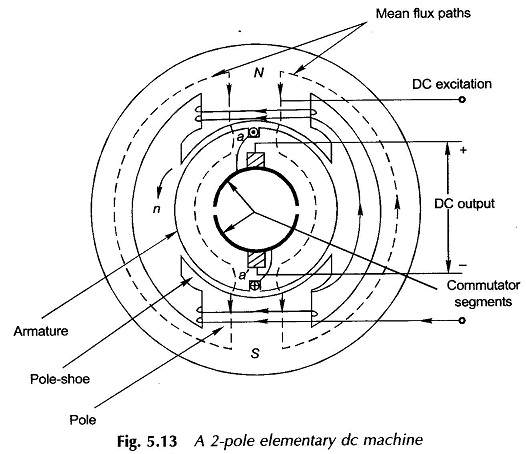**Understanding the Fundamentals of a 2-Pole Generator: A Step-by-Step Guide**
In the realm of electrical engineering, generators are crucial components that convert mechanical energy into electrical energy. Among the various types of generators, the 2-pole generator stands out for its simplicity and efficiency. This article delves into the intricacies of a 2-pole generator, focusing on its stator winding diagram, which is a crucial aspect of its operation. By exploring this diagram, readers will gain a deeper understanding of how a 2-pole generator functions and its applications in various industries.
what are the key components of a 2-pole generator stator winding diagram
 The key components of a 2-pole generator stator winding diagram include:
Full Loop Multi-Turn Stator Coils: These coils are used in model series 2400 and 2800 of 2-pole generators, providing a crucial aspect of their operation.
Stator Winding Structure: The simplified stator winding structure of a 2-pole three-phase novel toroidal winding permanent magnet synchronous generator features a specific arrangement of coils and connections, enhancing the efficiency of the generator.
Stator Winding Connection Ring: This component is crucial for liquid cooled generators, ensuring reliable connections between the stator winding and the end winding basket. It is designed to withstand thermal ageing and corrosion, and its maintenance is critical for the overall performance of the generator.
These components work together to facilitate the conversion of mechanical energy into electrical energy in a 2-pole generator, making them essential components of its stator winding diagram.
The key components of a 2-pole generator stator winding diagram include:
Full Loop Multi-Turn Stator Coils: These coils are used in model series 2400 and 2800 of 2-pole generators, providing a crucial aspect of their operation.
Stator Winding Structure: The simplified stator winding structure of a 2-pole three-phase novel toroidal winding permanent magnet synchronous generator features a specific arrangement of coils and connections, enhancing the efficiency of the generator.
Stator Winding Connection Ring: This component is crucial for liquid cooled generators, ensuring reliable connections between the stator winding and the end winding basket. It is designed to withstand thermal ageing and corrosion, and its maintenance is critical for the overall performance of the generator.
These components work together to facilitate the conversion of mechanical energy into electrical energy in a 2-pole generator, making them essential components of its stator winding diagram.what are the advantages of using full loop multi-turn stator coils in 2-pole generators
 The advantages of using full loop multi-turn stator coils in 2-pole generators include:
Economical Handling and Winding: Full loop multi-turn stator coils are more economical to handle and wind, particularly in hydrogenerators with many slots.
Improved Efficiency: The full loop design allows for better insulation and reduced losses, enhancing the overall efficiency of the generator.
Enhanced Performance: The full loop multi-turn stator coils are designed to provide a more uniform magnetic field, resulting in improved performance and reduced vibration.
Increased Flexibility: Full loop coils can be easily adapted to different generator sizes and applications, offering greater flexibility in design and manufacturing.
Reduced Maintenance: The full loop design reduces the number of connections and joints, making it easier to maintain and repair the generator.
These advantages make full loop multi-turn stator coils a popular choice for 2-pole generators, particularly in applications where efficiency and reliability are crucial.
The advantages of using full loop multi-turn stator coils in 2-pole generators include:
Economical Handling and Winding: Full loop multi-turn stator coils are more economical to handle and wind, particularly in hydrogenerators with many slots.
Improved Efficiency: The full loop design allows for better insulation and reduced losses, enhancing the overall efficiency of the generator.
Enhanced Performance: The full loop multi-turn stator coils are designed to provide a more uniform magnetic field, resulting in improved performance and reduced vibration.
Increased Flexibility: Full loop coils can be easily adapted to different generator sizes and applications, offering greater flexibility in design and manufacturing.
Reduced Maintenance: The full loop design reduces the number of connections and joints, making it easier to maintain and repair the generator.
These advantages make full loop multi-turn stator coils a popular choice for 2-pole generators, particularly in applications where efficiency and reliability are crucial.how do full loop multi-turn stator coils improve efficiency in 2-pole generators
Full loop multi-turn stator coils improve efficiency in 2-pole generators by reducing losses and enhancing the overall performance of the generator. This design allows for better insulation and reduced losses, which directly contributes to increased efficiency. #EANF#As we conclude our exploration of the 2-pole generator stator winding diagram, it is essential to emphasize the significance of understanding the intricacies of this crucial component. The diagram provides a comprehensive overview of the stator winding construction process, highlighting the importance of Class F insulation and vacuum pressure impregnation (VPI) in ensuring the efficiency and reliability of the generator. By delving into the details of the stator winding diagram, readers have gained valuable insights into the design and functionality of the 2-pole generator, which is critical for its optimal operation. The stator winding diagram serves as a vital tool for engineers and technicians, enabling them to troubleshoot and maintain these generators effectively.
In conclusion, the 2-pole generator stator winding diagram is a fundamental component in the operation of these generators. By understanding the intricacies of the stator winding construction process, readers have gained a deeper appreciation for the importance of precision and attention to detail in the design and manufacturing of these critical components. As we move forward in the development of more efficient and reliable generators, it is crucial that we continue to emphasize the importance of the stator winding diagram in ensuring the optimal performance of these devices. By doing so, we can ensure that our generators continue to meet the demands of a rapidly changing energy landscape, providing reliable and efficient power to our communities and industries.